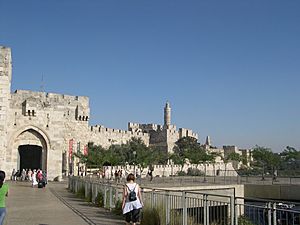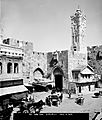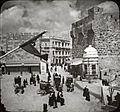Jaffa Gate facts for kids
The Jaffa Gate is a famous stone entrance in the old walls of Jerusalem's Old City. It's also known as the "Hebron Gate" or "Gate of David's Chamber." This gate is one of seven main gates that let people into the historic Old City.
Today, the name Jaffa Gate refers to two things. It means the original Ottoman gate built in 1538. It also refers to a wide opening in the city wall next to it. The old gate looks like a medieval gate tower. It has an L-shaped entrance. This entrance was protected at both ends with strong, heavy doors.
History of Jaffa Gate
The L-shaped design of the old gate was a clever defense. It was made to slow down any attackers. The outer part of the gate faced Jaffa Road. This was the road where travelers and pilgrims arrived after their journey from the port of Jaffa.
In 1898, a new opening was made in the wall. The Ottoman rulers created this gap. It was to let the German emperor Wilhelm II enter the city in a grand way. This opening and the ramp leading to it now allow cars to drive into the Old City from the west.
In 1908, a fancy clock tower was built on top of the old Jaffa Gate. It helped the growing business area nearby. It was also one of about 100 clock towers built across the Ottoman Empire. These towers celebrated 25 years of the Sultan's rule.
Both the Jaffa Gate and Jaffa Road are named after the port of Jaffa. This is where the Prophet Jonah began his sea journey. It's also where pilgrims landed for their trip to Jerusalem. Today, Jaffa Road is only the name for the street outside the Old City.
The clock tower was made from limestone. This stone came from a nearby place called Zedekiah's Cave. The tower was about 13 feet tall. It had four clock faces, one for each main direction. The east and west faces showed official time. The north and south faces showed local time. The clock tower only stood for 14 years. The British took it down in 1922.
Renovating the Gate
Many people and cars use Jaffa Gate every day. In the early 2000s, the road next to the gate was moved. A new open area, or plaza, was built instead. This plaza connects Jaffa Gate to the Mamilla shopping mall across the street.
In 2010, the Israel Antiquities Authority finished a two-month project. They restored and cleaned Jaffa Gate. This was part of a bigger project that started in 2007. The project cost $4 million to fix up the Old City walls. The clean-up included replacing broken stones. They also cleaned decades of car exhaust from the walls. An old Arabic writing from 1593 was reattached to the gate.
Bullet marks from the 1948 Arab–Israeli war were kept on the gate. Work near Jaffa Gate also uncovered an old aqueduct. This water channel dates back to the 2nd or 3rd century CE.
Images for kids
-
Inscription on the wall adjacent to, and north of, the outer gate, praising Allah and his servant, Ibrahim (1854 photograph)
-
View of Jaffa Gate (left) and the Tower of David (right).
See also
 In Spanish: Puerta de Jaffa para niños
In Spanish: Puerta de Jaffa para niños















